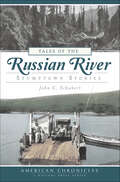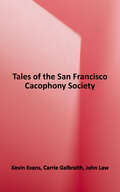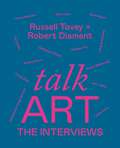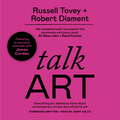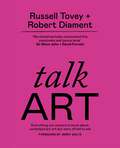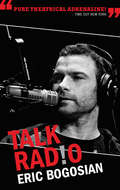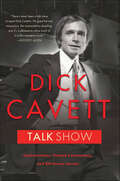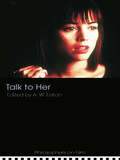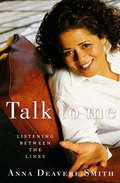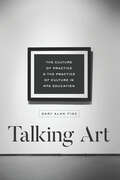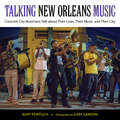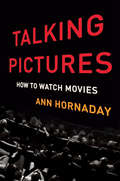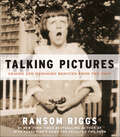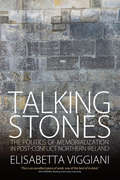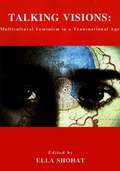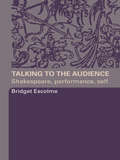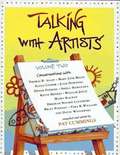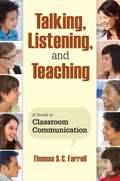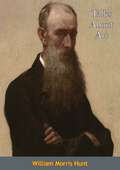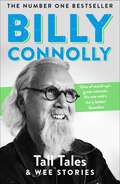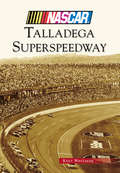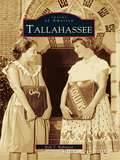- Table View
- List View
Tales of the Russian River: Stumptown Stories (American Chronicles)
by John C. SchubertThe Russian River has drawn tourists to its colossal redwoods, picturesque seashore and idyllic resorts for more than a century. This collection of John C. Schubert's "Stumptown Stories" columns relates the history of this California river valley through in-depth research and firsthand stories. Ride the first train to chug across the Hacienda Bridge and wave farewell to the town's last train in 1935. Swing around in the many dance halls to the big bands of the 1930s, '40s and '50s. Let the entertaining stories behind once stately, now hidden, landmarks carry you into Stumptown's past. Reconnect over coffee at Pat's Cafe and discover the rich history that formed the Russian River's communities.
Tales of the San Francisco Cacophony Society
by John Law Kevin Evans Carrie GalbraithA template for pranksters, artists, adventurers, and anyone interested in rampant creativity, this is the history of the most influential underground cabal that has never been exposed by the mainstream media. Rising from the ashes of the mysterious and legendary Suicide Club, the Cacophony Society at its zenith hosted chapters in most major US cities and influenced much of what was once called the 'underground'. Packed with original art, never before published photographs, original documents and incredulous news stories this is an homage to the San Francisco group.
Talk Art The Interviews (Talk Art)
by Russell Tovey Robert Diament'Insights from the zeitgeist are preserved with conviction and clarity, offering an inclusive way to access contemporary art in all its forms. If Talk Art is the fun podcast, then this book is the educational supplement to be prescribed alongside it.' - AestheticaThe authors of the Sunday Times bestseller Talk Art: Everything you wanted to know about contemporary art but were afraid to ask, have brought together 24 of the most profound, moving, funny and informative interviews from the wildly popular Talk Art podcast.These curated excerpts explore the inspirations, art experiences and favourite artists of a fascinating range of creative people from Grayson Perry to Elton John, from Tracey Emin to Paul Smith, and from Wolfgang Tillmans to Sonia Boyce, accompanied by images of the artworks that they have created or that have influenced them.The interviews featured include:- Jerry Saltz- Laurie Anderson- Stephen Fry- Elton John- Tracey Emin- Paul Smith - Sonia Boyce- Chila Burman - Rachel Whiteread- Wolfgang Tillmans - Pierce Brosnan - Grayson Perry
Talk Art The Interviews (Talk Art)
by Russell Tovey Robert Diament'Insights from the zeitgeist are preserved with conviction and clarity, offering an inclusive way to access contemporary art in all its forms. If Talk Art is the fun podcast, then this book is the educational supplement to be prescribed alongside it.' - Aesthetica'Where the collection really takes off is the interviews with younger artists, which are sensitive,unpatronising, genuinely questioning and fundamentally challenging....Indeed, this collection's strength ultimately lies in the fact that it reveals nothing more than a battlefield in its quest to establish what contemporary art is all about.' - ArtReviewThe authors of the Sunday Times bestseller Talk Art: Everything you wanted to know about contemporary art but were afraid to ask, have brought together 24 of the most profound, moving, funny and informative interviews from the wildly popular Talk Art podcast.These curated excerpts explore the inspirations, art experiences and favourite artists of a fascinating range of creative people from Grayson Perry to Elton John, from Tracey Emin to Paul Smith, and from Wolfgang Tillmans to Sonia Boyce, accompanied by images of the artworks that they have created or that have influenced them.The interviews featured include:- Jerry Saltz- Laurie Anderson- Stephen Fry- Elton John- Tracey Emin- Paul Smith - Sonia Boyce- Chila Burman - Rachel Whiteread- Wolfgang Tillmans - Pierce Brosnan - Grayson Perry
Talk Art: THE SUNDAY TIMES BESTSELLER Everything you wanted to know about contemporary art but were afraid to ask
by Russell Tovey Robert Diament***Includes an exclusive 'Turning the Tables on Talk Art' interview with James Corden*** 'As rabid admirers and collectors of contemporary art and photography we wholeheartedly recommend this passionate and joyous book. Without art the human soul is unfulfilled. This collection by Russell and Robert fully explains why.' Sir Elton John and David Furnish'Russell and Robert have made talking art not just pleasurable but necessary.'Lena Dunham 'As witty, wise and well informed as Russell and Robert's excellent podcast.'Edward Enninful, OBEWhen launching the Talk Art podcast in 2018, actor Russell Tovey and gallerist Robert Diament had one clear aim: to make the art world more accessible. Since then, the podcast has grown to be a global hit, featuring exclusive interviews with leading artists, curators, gallerists, actors, musicians and fellow art lovers such as Lena Dunham, Sir Paul Smith, David Shrigley, Noel Fielding, Edward Enninful, Rose Wylie and Sir Elton John.Talk Art, the book, is a celebration of contemporary art, and a guidebook to navigating and engaging with the art world. Covering a range of different media from photography and ceramics to performance and sound art, the book explores the way art interacts with our society, highlights lesser-known artists, and provides a snapshot of the art world as it is today.The book features highlights from interviews with: Tracey Emin, Jordan Casteel, Jerry Saltz, Elton John, Grayson Perry, Ian McKellen, Alasdair McLellan, Helen Cammock, Somaya Critchlow and many more. (p) 2021 Octopus Publishing Group
Talk Art: THE SUNDAY TIMES BESTSELLER Everything you wanted to know about contemporary art but were afraid to ask (Talk Art)
by Russell Tovey Robert Diament***'An indispensable volume'Vogue'As rabid admirers and collectors of contemporary art and photography we wholeheartedly recommend this passionate and joyous book. Without art the human soul is unfulfilled. This collection by Russell and Robert fully explains why.' Sir Elton John and David Furnish'Russell and Robert have made talking art not just pleasurable but necessary.'Lena Dunham 'As witty, wise and well informed as Russell and Robert's excellent podcast.'Edward Enninful, OBEWhen launching the Talk Art podcast in 2018, actor Russell Tovey and gallerist Robert Diament had one clear aim: to make the art world more accessible. Since then, the podcast has grown to be a global hit, featuring exclusive interviews with leading artists, curators, gallerists, actors, musicians and fellow art lovers such as Lena Dunham, Sir Paul Smith, David Shrigley, Noel Fielding, Edward Enninful, Rose Wylie and Sir Elton John.Talk Art, the book, is a beautiful and accessible celebration of contemporary art, and a guidebook to navigating and engaging with the art world. Covering a range of different media from photography and ceramics to performance and sound art, the book explores the way art interacts with our society, highlights lesser-known artists, and provides a snapshot of the art world as it is today.With a wealth of imagery - some never before seen in print and some created exclusively for the book - and an informative, engaging narrative, Talk Art will become the must-have book art lovers return to again and again. The book features highlights from interviews with: Tracey Emin, Jordan Casteel, Jerry Saltz, Elton John, Grayson Perry, Ian McKellen, Alasdair McLellan, Helen Cammock, Somaya Critchlow and many more. Praise for the podcast:'Lively, accessible and enthusiastic' - Financial Times'As fast-paced and gossipy as it is genuinely interesting' - Dazed'Trendy, gossipy, fast-paced conversational fun' - New York Times'It's an education, but not in an alienating highbrow way' - NME
Talk Radio (TCG Edition)
by Eric Bogosian"Your fear, your own lives, have become your entertainment."--Talk Radio"More timely today than it was twenty years ago . . . Radio crackles with intensity."--Joe Dziemianowicz, New York Daily News"The most lacerating portrait of a human meltdown this side of a Francis Bacon painting. . . . This revival, like the original production, allows its star to grab an audience by the lapels and shake it into submission."--Ben Brantley, The New York TimesEric Bogosian's Talk Radio--his breakthrough 1987 Public Theater hit that was made into a film by Oliver Stone--has been revived in a "mesmerizing" (Newsday) production on Broadway, with Liev Schreiber playing the role of the late-night shock jock that Bogosian himself originated. The drama is set in the studio of Cleveland's WTLK Radio over the course of Barry Champlain's two-hour broadcast, being scrutinized that night by producers with an interest in taking the show national, and fueled as always by coffee, cocaine, and Jack Daniel's. Barry's jousts with his unseen callers--ranging from a white supremacist to a woman obsessed with her garbage disposal--are peppered with insights into his character from his ex-deejay pal and his sometime girlfriend/producer, and punctuated with a transformative visit from an embodied voice. Eric Bogosian is a writer and actor who over the last twenty years has authored five full-length plays and created six full-length solos for himself, including subUrbia; Sex, Drugs, Rock & Roll; Pounding Nails in the Floor with My Forehead;and Drinking in America. He is the recipient of three OBIE Awards and a Drama Desk Award, and has toured throughout the United States and Europe.
Talk Show: Confrontations, Pointed Commentary, and Off-Screen Secrets
by Dick CavettThe legendary talk show host’s humorous reminiscences and pointed commentary on the great figures he has known, and culture and politics today.For years, Dick Cavett played host to the nation’s most famous personalities on his late-night talk show. In this humorous and evocative book, we get to hear Cavett’s best tales, as he recounts great moments with the legendary entertainers who crossed his path and offers his own trenchant commentary on contemporary American culture and politics.Pull up a chair and listen to Cavett’s stories about one-upping Bette Davis, testifying on behalf of John Lennon, confronting Richard Nixon, scheming with John Updike, befriending William F. Buckley, and palling around with Groucho Marx. Sprinkled in are tales of his childhood in Nebraska in the 1940s and 1950s, where he honed his sense of comic timing and his love of magic.Cavett is also a wry cultural observer, looking at America today and pointing out the foibles that we so often fail to notice about ourselves. And don’t even get him started on politicians. A generation of Americans ended their evenings in Dick Cavett’s company; Talk Show is a way to welcome him back.“Do you know that age-old question, If you could have dinner with anyone in the world, living or dead, who would it be? Well, assuming Santa Claus is unavailable, my answer would be Dick Cavett. After reading Talk Show, you could just imagine what a conversation with him would be like: pleasant, insightful, and oddly erotic. Dick Cavett is a legend and an inspiration to me.” —Jimmy Fallon
Talk to Her (Philosophers on Film)
by A. W. EatonPedro Almodóvar is one of the most renowned film directors of recent years. Talk to Her is one of the most discussed and controversial of all his films. Dealing principally with the issue of rape, it also offers profound insights into the nature of love and friendship whilst raising important philosophical and moral questions in unsettling and often paradoxical ways. This is the first book to explore and address the philosophical aspects of Almodóvar’s film. Opening with a helpful introduction by Noël Carroll that places the film in context, specially commissioned chapters examine the following topics: The relationship between art and morality and the problem of 'immoralism' Moral injury and its role in the way we form moral judgments, including the ethics of love and friendship The nature of dialogue, sexual objectification and what 'listening to' means in the context of gender Almodóvar's use of allusion and the unmasking of appearances to explore hidden themes in human nature. Including a biography of Almodóvar, Talk to Her is essential reading for students interested in philosophy and film as well as ethics and gender. It is also provides an accessible and informative insight into philosophy for those in related disciplines such as film studies, literature and religion. Contributors: Noël Carroll, A. W. Eaton, Cynthia Freeland, Robert B. Pippin, C.D.C. Reeve, and George M. Wilson
Talk to Me
by Anna Deavere SmithAnna Deavere Smith, the award-winning playwright and actor, has spent a lifetime listening--really listening--to the people around her. As a child in the segregated Baltimore of the early 1960s, Smith absorbed the words of her parents, teachers, neighbors--even train conductors--and realized that there was something more being communicated than the actual words: The conductor's voice had a mild kind of grandeur that was a cousin to the vocal tones I had heard at funerals--"Ashes-to-ashes"--and at christenings and weddings. These are words that have been said many times, but the person who speaks them understands that each time it must be said as if it matters, because it does matter. We never know what lies ahead, and we never know what just happened, and all words must house respect of those two unknowns. In Talk to Me, Smith looks back at a singular career as a seeker and interpreter of language in America, revealing the methodology behind her extraordinary search for the truth and nuances of verbal communication. For thirty years, the defining thesis of Smith's work has been that how we speak is just as important in communicating truth and identity as what we say. Everything from individual vocal tone to grammar, Smith demonstrates, can be as identifiable and revealing as a fingerprint. Her journey has taken her from the rarefied bastions of academia to riot-torn streets; she has conducted hundreds of interviews with subjects ranging from women prisoners to presidents of the United States. In 1995, her ongoing investigation led her to Washington, D. C. After all, what better place to wage an inquiry into the power of language and the language of power than in the city where "message" is a manufactured product? What happens when we as citizens accept--which we seem to be doing more and more--our chosen leaders' failure to tell the truth? And how can we know that we are hearing what Washington really has to say when everything we receive is filtered through the media? Armed with a blazing intellect and a tape recorder, Smith tackled these questions head-on, conducting more than four hundred interviews with people both inside and outside the power structure of Washington. She recorded these sessions in her trademark verbatim transcripts, which include every tic and verbal utterance of her subjects. More than thirty of these remarkable documents appear in this book, including interviews with Bill Clinton, Anita Hill, Studs Terkel, George Bush, Mike McCurry, and Helen Thomas. After five years of searing investigation into the world of the politicians, spin doctors, and power brokers who are steering the course of our country from inside the beltway, Smith has come away with a revelatory assessment--by turns devastating and hopeful--of the lexicon of power and politics in America. Talk to Me is a landmark contribution from a woman whose pioneering insights into language speak volumes.
Talking Art: The Culture of Practice & the Practice of Culture in MFA Education
by Gary Alan FineIn Talking Art, acclaimed ethnographer Gary Alan Fine gives us an eye-opening look at the contemporary university-based master’s-level art program. Through an in-depth analysis of the practice of the critique and other aspects of the curriculum, Fine reveals how MFA programs have shifted the goal of creating art away from beauty and toward theory. Contemporary visual art, Fine argues, is no longer a calling or a passion—it’s a discipline, with an academic culture that requires its practitioners to be verbally skilled in the presentation of their intentions. Talking Art offers a remarkable and disconcerting view into the crucial role that universities play in creating that culture.
Talking New Orleans Music: Crescent City Musicians Talk about Their Lives, Their Music, and Their City (American Made Music Series)
by Burt FeintuchIn New Orleans, music screams. It honks. It blats. It wails. It purrs. It messes with time. It messes with pitch. It messes with your feet. It messes with your head. One musician leads to another; traditions overlap, intertwine, nourish each other; and everyone seems to know everyone else. From traditional jazz through rhythm and blues and rock 'n' roll to sissy bounce, in second-line parades, from the streets to clubs and festivals, the music seems unending. In Talking New Orleans Music, author Burt Feintuch has pursued a decades-long fascination with the music of this singular city. Thinking about the devastation—not only material but also cultural—caused by the levees breaking in 2005, he began a series of conversations with master New Orleans musicians, talking about their lives, the cultural contexts of their music, their experiences during and after Katrina, and their city. Photographer Gary Samson joined him, adding a compelling visual dimension to the book. Here you will find intimate and revealing interviews with eleven of the city's most celebrated musicians and culture-bearers—Soul Queen Irma Thomas, Walter “Wolfman” Washington, Charmaine Neville, John Boutté, Dr. Michael White, Deacon John Moore, Cajun bandleader Bruce Daigrepont, Zion Harmonizer Brazella Briscoe, producer Scott Billington, as well as Christie Jourdain and Janine Waters of the Original Pinettes, New Orleans's only all-woman brass band. Feintuch's interviews and Samson's sixty-five color photographs create a powerful portrait of an American place like no other and its worlds of music.
Talking Pictures: How to Watch Movies
by Ann HornadayWhether we are trying to impress a date after an art-house film screening or discussing Oscar nominations with friends, we all need ways to watch and talk about movies. But with so much variety between an Alfred Hitchcock thriller and a Nora Ephron romantic comedy, how can everyday viewers determine what makes a good movie?In Talking Pictures, veteran film critic Ann Hornaday walks us through the production of a typical movie-from writing the script and casting to the final sound edit-and explains how to evaluate each piece of the process. How do we know if a film is well-written, above and beyond snappy dialogue? What constitutes a great screen performance? What goes into praiseworthy cinematography, editing, and sound design? And what does a director really do? Full of engaging anecdotes and interviews with actors and filmmakers, Talking Pictures will help us see movies in a whole new light-not just as fans, but as film critics in our own right.
Talking Pictures: Images and Messages Rescued from the Past
by Ransom RiggsA unique collection of vintage images from the author of the New York Times bestselling illustrated novel Miss Peregrine’s Home for Peculiar Children.With the candid quirkiness of Awkward Family Photos and the confessional intimacy of PostSecret, Ransom Riggs’s Talking Pictures is a haunting collection of antique found photographs with evocative inscriptions that bring these lost personal moments to life. Each image reveals a singular, frozen moment in a person’s life, be it joyful, quiet, or steeped in sorrow. Yet the book’s unique depth comes from the writing accompanying each photo: as with the caption revealing how one seemingly random snapshot of a dancing couple captured the first dance of their forty-year marriage, each successive inscription shines like a flashbulb illuminating a photograph’s particular context and lighting up our connection to the past. “I’m absolutely fascinated . . . there’s just enough written [on the photos] to make each image more powerful, and leave you wanting to know more.” —Boingboing
Talking Stones: The Politics of Memorialization in Post-Conflict Northern Ireland
by Elisabetta ViggianiIf memory was simply about past events, public authorities would never put their ever-shrinking budgets at its service. Rather, memory is actually about the present moment, as Pierre Nora puts it: "Through the past, we venerate above all ourselves." This book examines how collective memory and material culture are used to support present political and ideological needs in contemporary society. Using the memorialization of the Troubles in contemporary Northern Ireland as a case study, this book investigates how non-state, often proscribed, organizations have filled a societal vacuum in the creation of public memorials. In particular, these groups have sifted through the past to propose "official" collective narratives of national identification, historical legitimation, and moral justifications for violence.
Talking to the Audience: Shakespeare, Performance, Self
by Bridget EscolmeThis unique study investigates the ways in which the staging convention of direct address - talking to the audience - can construct selfhood, for Shakespeare's characters. By focusing specifically on the relationship between performer and audience, Talking to the Audience examines what happens when the audience are in the presence of a dramatic figure who knows they are there. It is a book concerned with theatrical illusion; with the pleasures and disturbances of seeing 'characters' produced in the moment of performance.Through analysis of contemporary productions Talking to the Audience serves to demonstrate how the study of recent performance helps us to understand both Shakespeare's cultural moment and our own. Its exploration of how theory and practice can inform each other make this essential reading for all those studying Shakespeare in either a literary or theatrical context.
Talking with Artists
by Pat CummingsDistinguished picture book artists talk about their early art experiences, answer questions most frequently asked by children, and offer encouragement to aspiring artists.
Talking, Listening, and Teaching: A Guide to Classroom Communication
by Thomas S. FarrellTalking, Listening, and Teaching demonstrates how important it is for teachers to understand and monitor classroom communication patterns and resolve problems that may hamper students' learning. Using examples from real classrooms, the author explainsHow classroom talk is different from communication outside the classroomHow to gather and analyze data about classroom talkWhat type of questioning generates good discussionsWhy and how to give feedback to studentsHow nonverbal communication impacts the classroomThis insightful guide to classroom communication, featuring provocative "Thinking About Your Own Classroom" questions, is ideal for teacher study groups and benefits educators who wish to effectively manage this important aspect of teaching and learning.
Talks About Art: With A Letter From J. E. Millais
by William Morris Hunt Helen M. KnowltonWilliam Morris Hunt (March 31, 1824 – September 8, 1879) was an American painter.Born into the political Hunt family of Vermont, he trained in Paris with the realist Jean-François Millet and studied under him at the Barbizon artists’ colony, before founding a similar group on his return to America. He became Boston's leading portrait and landscape painter, also working as a lithographer and sculptor. In 1871 he was elected into the National Academy of Design as an Associate Academician. Many of his works were destroyed in the Great Boston Fire of 1872. Another disaster was the deterioration of the stone panels in the State Capitol at Albany, New York, on which a number of his murals had been painted. This is believed to have led to his depression and presumed suicide.
Tall Tales and Wee Stories: The Best of Billy Connolly
by Billy Connolly80TH BIRTHDAY EDITION - NOW WITH 10 NEW TALL TALES! THE SUNDAY TIMES BESTSELLER'Connolly's raucous run through his life is as furious, funny and foul-mouthed as you'd expect' Sunday TimesIn December 2018, after fifty years of belly-laughs, energy and outrage, Billy Connolly announced his retirement from live stand-up comedy. It had been an extraordinary career.When he first started out in the late sixties, Billy played the banjo in the folk clubs of Scotland. Between songs, he would improvise a bit, telling anecdotes from the Clyde shipyard where he'd worked. In the process, he made all kinds of discoveries about what audiences found funny, from his own brilliant mimes to the power of speaking irreverently about politics or explicitly about sex. He began to understand the craft of great storytelling. Soon the songs became shorter and the monologues longer, and Billy quickly became recognised as one of the most exciting comedians of his generation.Tall Tales and Wee Stories brings together the very best of Billy's storytelling for the first time and includes his most famous routines including, The Last Supper, Jojoba Shampoo, Incontinence Pants and Shouting at Wildebeest. With an introduction and original illustrations by Billy throughout, it is an inspirational, energetic and riotously funny read, and a fitting celebration of our greatest ever comedian.
Tall Tales and Wee Stories: The Best of Billy Connolly
by Billy Connolly80TH BIRTHDAY EDITION - NOW WITH 10 NEW TALL TALES! THE SUNDAY TIMES BESTSELLER'Connolly's raucous run through his life is as furious, funny and foul-mouthed as you'd expect' Sunday TimesIn December 2018, after fifty years of belly-laughs, energy and outrage, Billy Connolly announced his retirement from live stand-up comedy. It had been an extraordinary career.When he first started out in the late sixties, Billy played the banjo in the folk clubs of Scotland. Between songs, he would improvise a bit, telling anecdotes from the Clyde shipyard where he'd worked. In the process, he made all kinds of discoveries about what audiences found funny, from his own brilliant mimes to the power of speaking irreverently about politics or explicitly about sex. He began to understand the craft of great storytelling. Soon the songs became shorter and the monologues longer, and Billy quickly became recognised as one of the most exciting comedians of his generation.Tall Tales and Wee Stories brings together the very best of Billy's storytelling for the first time and includes his most famous routines including, The Last Supper, Jojoba Shampoo, Incontinence Pants and Shouting at Wildebeest. With an introduction and original illustrations by Billy throughout, it is an inspirational, energetic and riotously funny read, and a fitting celebration of our greatest ever comedian.
Tall: the design and construction of high-rise architecture
by John Sutherland Guy Marriage Nabil Jose Allaf Gerard Finch Lauren HayesThis is a guide to both the basics and the details of tall building design, delving into the rudimentary aspects of design that an architect of a tall office building must consider, as well as looking at the rationale for why and how a building must be built the way it is. Liberally illustrated with clear, simple black and white illustrations showing how the building structure and details can be built, this book greatly assists the reader in their understanding of the building process for a modern office tower. It breaks down the building into three main components: the structure, the core and the facade, writing about them and illustrating them in a simple-to-understand manner. By focusing on the nuts and bolts of real-life design and construction, it provides a practical guide and desk-reference to any architect or architecture student embarking on a tall building project.
Talladega Superspeedway
by Kent WhitakerOriginally named Alabama International Motor Speedway, Talladega Superspeedway was built on the site of a World War II-era Air Force base in the heart of Alabama. NASCAR founder Bill France and his family envisioned a race track that would be faster, larger, and more exciting than any track built to date. Construction began on May 23, 1968, and was completed on September 13, 1969. The end result is the most modern speedway ever built. Often simply referred to as "Dega," the track is 2.66 miles long, its high-banked turns are nearly three stories tall, and race cars have reached speeds over 200 miles per hour. It is so popular that it is said to become one of the largest "temporary" cities in the state every race weekend.
Tallahassee (Images of America)
by Erik T. RobinsonLocated in the rolling hills of Florida's Panhandle, Tallahassee has long stood as a capital city. It has been home to prehistoric Native Americans, who built the Lake Jackson Mounds in the 13th century; the Apalachee Indians, who learned to live with the Spanish Mission in the 17th century; and to European settlers and the American residents of today. Tallahassee's tree-lined, canopied roads and bountiful dogwoods and azaleas have always been associated with the leadership and history of the state. The presence of institutions such as Florida State University and Florida A&M have also made Tallahassee an attractive center of higher learning and diversity. Throughout prosperity and adversity, both Tallahassee's population and complexity have continued to increase. Combining historic landmarks, such as the San Luis Archaeological Site and the Old City, and new neighborhoods, such as Frenchtown and Lafayette Park, the capital city is a unique representation of Florida, from its days as a territory to its status as one of the country's most visited states.
